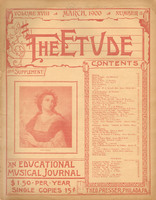St. Cecilia, the patron of church music, suffered martyrdom at Rome under Alexander Serverus about the year 229 A.D., although the date of her death has been variously placed by historians as occurring as early as A.D. 176 and 180, and placing the event in Sicily during the reign of Marcus Aurelius. Certain it is, however, that she lived at Rome, was of noble birth, and suffered her fate from the hands of pagan zealots for refusing to forswear her vows made to Christianity.
Her life, as it is reflected from the deep twilight of history and viewed by the intelligent curiosity of today, leaves little to be desired in the way of sweetness and purity of enthusiasm or greatness of sentiment and romantic interest. Reared in the bosom of a family actuated toward the highest expressions of culture by an earnest belief in the teachings of Paul of Tarsus, St. Cecilia early manifested a holy ardor for the religion of her parents, and subsequently resolved to dedicate herself to the service of her chosen faith. However, she was forced to wed with a certain Valerianus, whom she succeeded in converting and who was led to respect her vow. Shortly after, Valerianus, together with his brother, who had also embraced the teachings of Christianity, were seized by the pagan authorities and beheaded, while the virgin-wife was doomed to death through torture. This failing, an executioner was sent to Cecilia’s palace with orders to behead her also. So ineffectually did he do his task, however, that his victim lived for three days after, and though mortally wounded continued to preach the doctrines of her faith to such effort that in that short space of time over four hundred pagans were converted. After her death a church was erected over her house in Rome into which, in 821 a.d., her body and the remains of her husband and brother were translated. This sanctuary has since been twice repaired and gorgeously decorated. This much history tells us. As to the musical accomplishments of St. Cecilia, fact ceases, and reliance can only be placed upon tradition and the legendary lore with which the Catholic church is so richly appareled. That she was a singer or player of any instrument has never been proved. Yet influencing, as she did, to a very great extent, the age in which she lived, it is not at all to be wondered at that her youth, beauty, and inspired martyrdom have consecrated her for all time. Nor is it the less illogical to associate her memory with the sweetest and most powerful of all arts: music.



